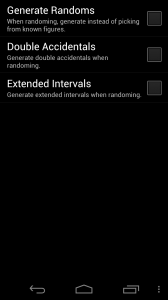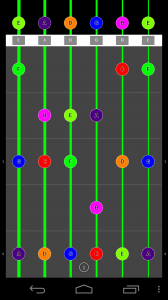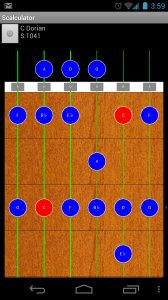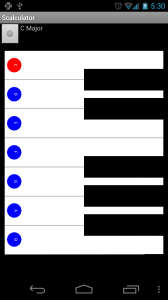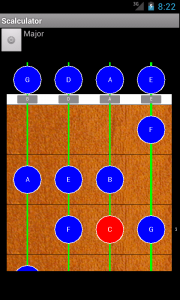I just released version 1.1 of the Scalculator Ultimate Edition! This version moves much closer to what I want the Scalculator to be – here’s a quick look at the functionality:
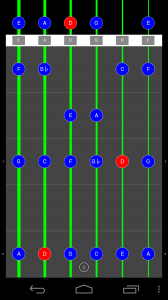
Full Screen Fretboard / Keyboard
One of the challenges I keep running into is how to organize and present all the information, and a good first step is to maximize the space available.
To this end, there’s no more buttons or information displayed on the “instrument view”, it’s all full screen – now there is a small icon at the center bottom to pull up a “information pane” (SlidingDraw in Android-speak) where all the information and options lie.
Information Pane
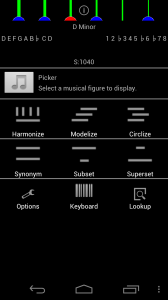
…And here’s where everything lives now, there’s the basic information at the top, like scale name, notes, formula, and any comments.
Below that is a bunch of buttons — that need styling and better icons I know — which expose some of the true utility and power of the Scalculator.
These things might move around a bit in the future, but I like the basic arrangement.
Let’s look at those options closer.
Picker
This just brings up possible root notes and scales/arpeggios to display. Eventually I’ll work up a nice cool way to select these things, rather than the boring list. For now, it’ll do.
Harmonize / Modelize / Circlize
 These are 3 different ways to generate additional figures based on the selected one.
These are 3 different ways to generate additional figures based on the selected one.
Harmonize – Loosely described, this generates chords based on the scale – by stacking a certain amount of notes separated by a certain interval. Normally, you might do this by stacking thirds against the diatonic scale, but the Scalculator will stack any intervals you like against any scale!
Modelize – This generates “modes”, either “by key” or “by root”. In common terms, you might get the modes of C Ionian by key: D Dorian, E Phyrgian, and so on. By root, these would be C Ionian, C Dorian, C Phrygian, and so on. And, of course, you can “Modelize” any figure.
Circlize – This generates a “circle of intervals”, like the common “Circle of Fifths”, but 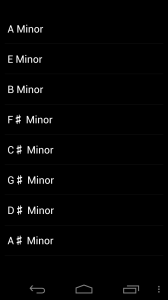 against any figure and on any interval. Hopefully, it will end up back on the starting root note!
against any figure and on any interval. Hopefully, it will end up back on the starting root note!
Sometimes the results of these machinations will result in un-named figure, but the Scalculator will still map out the results for you.
Synonym / Subset / Superset
These options basically show you things are the same, contain or are contained by the selected figure.
Very helpful to finding out what chords are in what scales.
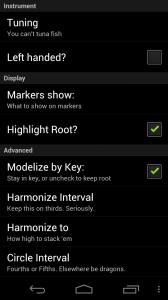
Options
Once you know what the Scalculator can do, the options are pretty self-explanatory (to me, at least).
You can play with the interval selections to harmonize on and so forth here – changing some of the advanced options will probably result in lots of unknown figures, but that’s all part of the fun!
Fretboard/Keyboard Toggle
You can easily toggle between Fretboard and Keyboard display according to your desired preference.
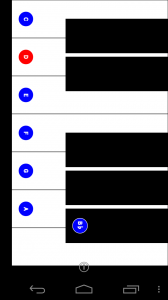
Reverse Lookup
When in lookup mode, the little “circle i” will change into a question mark, and you can tap the frets (or keys) to enter in some notes to lookup.
Once you are done typing in 3 or more notes, just pull the info pane up again, and the Scalculator will try to lookup the notes!
There is a particular method that lookup uses:
- Try to find a scale.
- Try to find an arpeggio.
- Try to find inversions of an arpeggio.
- Give up, and just show the notes.
Summary
Well, that’s it – a pretty in-depth look at the Scalculator! Next up is making an ad-supported version and a few days of bug-squashing.
Once all the obvious bugs are squashed, it’s on to implementing (in no particular order):
- Sound
- Chords (as in fingering charts)
- More scales and arpeggios
- Cleaner interface
And, finally, source code is up as well!
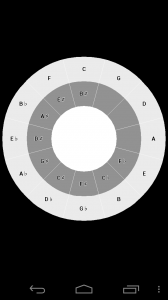 So, one of the things I have been trying to work out is a better “Root Note Picker”. The Scalculator supports a wide-range of notes, but picking them from a simple stock widget is tedious (there are nearly 3 dozen possibilities, so I only ever listed a basic 12.)
So, one of the things I have been trying to work out is a better “Root Note Picker”. The Scalculator supports a wide-range of notes, but picking them from a simple stock widget is tedious (there are nearly 3 dozen possibilities, so I only ever listed a basic 12.)